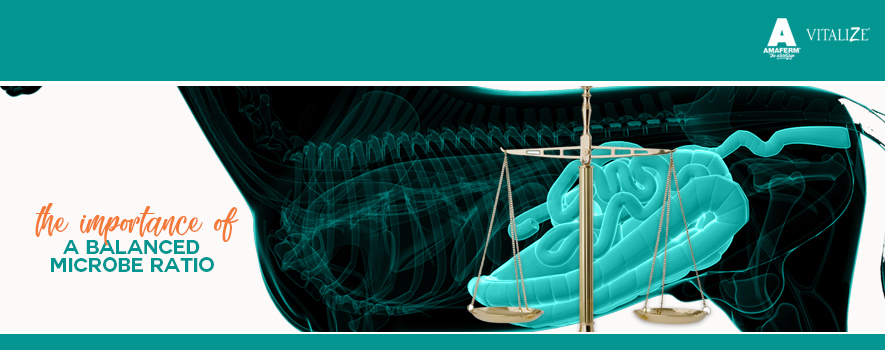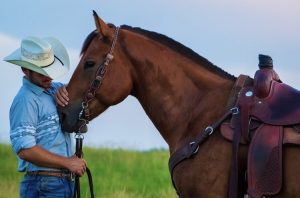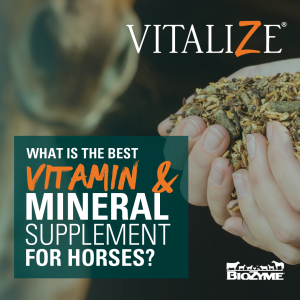
Gut microbes: the good and the bad
All horses have a resident population of microbes (microscopic “bugs”) living in their digestive system. This population is referred to as the gut microbiome and includes many different types of bacteria, fungi and protozoa, some of which are good for the gut and some of which are bad for the gut. The majority of the microbes are found in a part of the digestive tract called the cecum, a pouch at the end of the stomach and the large intestine. Collectively, the cecum and large intestine are often referred to as the “hindgut.” Just one drop of fluid from the hindgut contains hundreds of million, maybe even one billion, microbes! Undigested feed from the stomach and small intestine enters the cecum to undergo digestion with the assistance of these microbes.
Microbes in the gut have different functions. These include breaking down and digesting fiber from forages, breaking down protein, producing B vitamins and supplying the horse with energy. Interestingly, research shows that the proportion of beneficial microbes that inhabit a horse’s hindgut vary greatly from individual to individual. The unique composition of microbes found in each horse may help explain why some horses can eat anything while others are very sensitive and may colic from the slightest change in diet.
Unfortunately, along with the good microbes there are often some bad ones too. Some of these actually have important responsibilities, such as digesting starches. However, starch-digesting microbes release lactic acid that can lower the pH of the gut. Maintaining a healthy gut is all about microbial balance, keeping the population of good bugs large and bad bugs small. If the population of starch digesting microbes starts to grow and produce more lactic acid, the pH can be significantly altered such that the good microbes, which prefer a neutral pH, start to die off. The situation becomes critical when the bad bugs start to outnumber the good bugs. Not only does this prevent forages from being digested adequately, but it also allows pathogenic bugs to colonize and wreak havoc on the gut.
What causes imbalances?
An imbalance between the good and bad gut microbes in the gastrointestinal tract in any specie is collectively referred to as a state of dysbiosis. In horses, disruptions in the gut microbiome that cause dysbiosis include diet changes, starch overload, weather or environmental changes, antibiotic therapy, or a myriad of other things that result in stress. The symptoms of an imbalance within the gut microbe population include an irritable horse that may have gas, diarrhea, colonic ulcers or chronic colic. It is important to understand that microbial imbalances can affect horses differently. For example, in some cases an imbalance may cause weight loss and difficulty maintaining body condition. However, in other cases, obesity and laminitis may result. The best way to determine if dysbiosis is affecting your horse is thru fecal samples, which can be analyzed by a veterinarian to determine potential imbalances.
Prevention and treatments
An easy, consistently effective treatment for restoring the balance between the gut microbes has not yet been established. Much of the problem relates to knowing what exactly the correct balance is for each individual horse. Fortunately though, there are a few simple ways to make sure you maintain a good balance of the microbes that are normal for your horse.
First and foremost, it is important to provide the horse with enough forage in the diet. Horses are naturally grazing animals, meaning that they are designed to eat small quantities of forage often. It is best if we try to mimic their grazing lifestyle even if they are housed in a stall.
Second, avoid feeding starch or grain in large portions to keep lactic acid producing microbes at bay. Also, make changes in the horse’s diet slowly and gradually to allow the population of microbes to adjust to the changes in substrate.
Lastly, feeding a prebiotic like Amaferm® can be helpful for encouraging the right balance of microbes. Amaferm is proven to enhance the efficiency and quantity of beneficial bacteria and fungi in the gut. Plus, the prebiotic nature of Amaferm means it always works, even while administering antibiotics or after sitting in a below freezing feed room!
You can give your horse the advantage of Amaferm by feeding any of the Vitalize® daily products. If you suspect dysbiosis, Vitalize Digest More® Plus is a particularly good option. This daily pellet combines the benefits of Amaferm for the good microbes with MOS, another prebiotic that works to rid the gut of the bad microbes.

